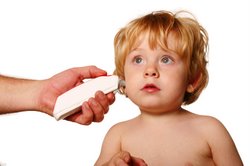The truth about fevers
In 1876, Claude Bernard, a French physician, studied fever in animals, and showed that if the body temperature of an animal was raised by 5 to 6 degrees, he would die. This forever changed our view of fever, for prior to this work, fever was viewed as one of the best of the natural defenses of the body. It was essential in fighting infections, and even encouraged the body to “burn out” the disease.
 Gradually fever began to be viewed as a disease. Now we suppress a fever in children as soon as we can, and as completely as possible. This is the major reason parents call their pediatricians and the major cause of visits to the emergency room. Misconceptions abound concerning fevers and the damage they can cause. The good effects of most fevers are rarely ever realized in a childhood illness.
Gradually fever began to be viewed as a disease. Now we suppress a fever in children as soon as we can, and as completely as possible. This is the major reason parents call their pediatricians and the major cause of visits to the emergency room. Misconceptions abound concerning fevers and the damage they can cause. The good effects of most fevers are rarely ever realized in a childhood illness.
Fever is natural
Most bacteria and viruses that cause infections thrive at normal body temperatures. So raising the temperature by a few degrees is the body’s way of fighting infection by making conditions less suitable for the survival and reproduction of the infectious agent. A fever will also activate the body’s immune system by encouraging the production of white blood cells, antibodies and other infection-fighting agents.
Do I treat or not?
However, today we most often rely on drugs to heal us, we have very little trust in the body’s ability to heal itself. In alternative medicine we take a different approach. The goal is to bolster and support the child’s immune system so that it can learn to recognize and respond quickly to any invading organism. In essence, you are training the immune system for a long and healthy life of fighting off illness!
Study the child’s overall condition, rather than just the thermometer. If he is comfortable, active, eating and drinking well, then wait. If he or she is playing video games, fighting with his sibling, and overall active throughout the day, then see if his body can fight the infection alone.
To make the child more comfortable, one safe and practical way to bring the fever down is a tepid sponge bath.
Sponge Bath
Use tepid (lukewarm) water only, not cold water, no ice or alcohol.
1. With a washcloth gently bathe one section of the body at a time, moving from head to toe.
2. Only uncover the part of the body being bathed.
3. Alternatively, if the child wishes, he or she may get into a lukewarm bathtub.
4. Repeat as often as necessary, even several times in succession, finishing at the toes and starting again at the head.
5. This gently lowers the fever to a comfortable level.
6. This treatment is meant to be soothing and comforting, as well as therapeutic.
Know when to take action
There are times when intervention is needed, and here are some signs you should keep in mind.
- Fever in a child under 3 months old
- Continuous fever of 4-5 days
- Fever above 104 degrees Fahrenheit
- Lethargy, very low energy
- Skin rashes
- Inconsolable crying
- Headache or stiff neck with aversion to light
Homeopathy can help
Some fevers require intervention with homeopathy, and we have some effective remedies for fevers in our toolbox. These are remedies which help the immune system to finish its job of healing. They include: Belladonna, Ferrum Phosphoricum, Gelsemium and Pulsatilla. It is good to have a kit at home with these remedies if your child has a tendency to frequent fevers. Often your homeopath can quickly choose which of these would be appropriate with just a brief phone call.

